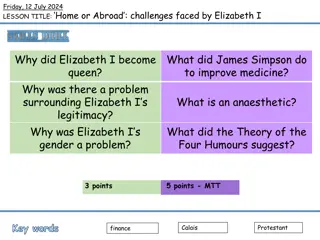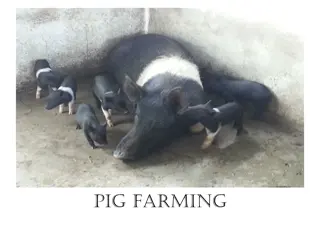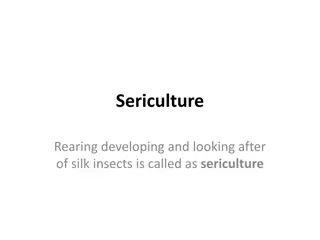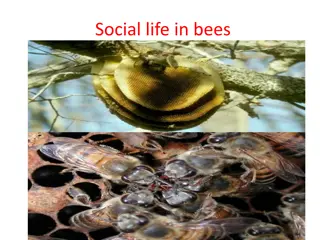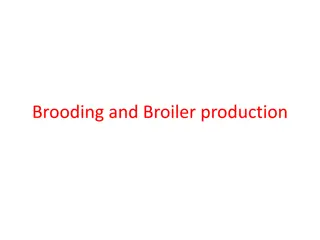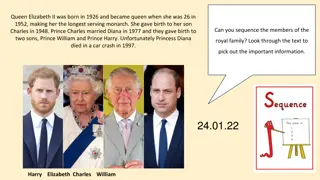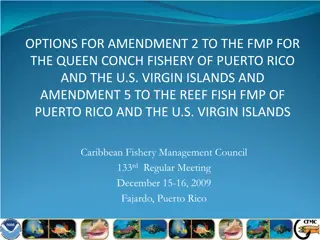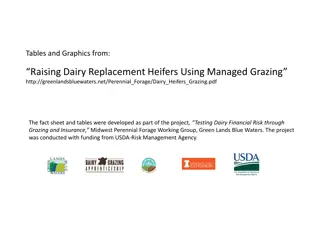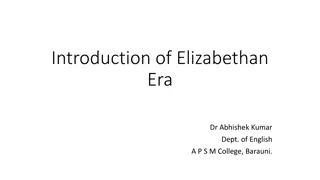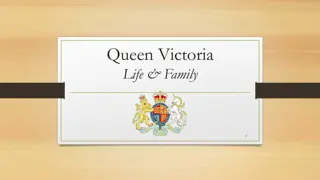Understanding Queen Rearing in Apiary Management
Explore the basic concepts of queen rearing for hobbyist beekeepers, including low and medium technology methods, breaking the brood cycle for mite control, and the process of using a queenless hive to produce well-fed queen cells. Discover considerations for timing, equipment, and methodologies while delving into the fundamental principles behind queen rearing. References from experts like C.C. Miller shed light on the intricacies of nurturing queen bees for a thriving apiary.
Download Presentation

Please find below an Image/Link to download the presentation.
The content on the website is provided AS IS for your information and personal use only. It may not be sold, licensed, or shared on other websites without obtaining consent from the author. Download presentation by click this link. If you encounter any issues during the download, it is possible that the publisher has removed the file from their server.
E N D
Presentation Transcript
Queen Rearing as a Tool in Apiary Management BASIC CONCEPTS FOR THE HOBBYIST PHILADELPHIA BEEKEEPERS GUILD MAY 17, 2018
Overview Basic Queen Rearing Concepts Queen Rearing (Low Technology) Queen Rearing (Medium Technology) Breaking the Brood Cycle for Mite Control
Queen Rearing A process using one strong queenless hive to produce many well-fed queen cells at the same time Before they emerge and kill one another, they are each given their own mating nucleus hive to emerge into and reside in, at least until they are fully mature. http://www.bushfarms.com/beesafewgoodqueens.htm
Mating Nucleus 4-way mating nucs (2 frames each) Can remove one partition for 2-way nucs (4 frames each) Can use individual 4-frame or 5-frame nucs Various other mating nuc configurations in catalogs
Considerations When to do it: raise queens during the early summer Why do it: requeen with our own queens late summer because queens mated before the summer solstice slow down egg-laying after the solstice but queens mated after the solstice act like a spring queen, not shutting down until October (M.Disselkoen) How to do it: Basic methods, equipment, mechanics, and timing as follows . . .
Basic Concepts A queenless hive of honey bees will try to make a new queen if it has: larva of an appropriate age (see next slide) sufficient food sufficient worker bees ambient* drones (for mating with the new queen) When nurse bees encounter larva in cells that hang down they tend to treat them as queen cells. This concept is central to most queen rearing methods. *not from the same hive as the new queen
Fifty Years Among the Bees, C.C. Miller "A queen is . . . fed throughout her larval lifetime on the same food that is given to a worker-larva during the first three days of its larval existence. So a worker-larva more than six days from the laying of the egg, would be too old for a good queen. Give them larv of all ages from which to select, and they always choose that which is two days old, or younger. http://biobees.com/library/general_beekeeping/bee keeping_books_articles/50_years_bees.pdf
Ways to Create Cells that Hang Down www.illinoisqueeninitiative.com/howto/queen- rearing/ The Alley Method low tech The Miller Method low tech Quinby/Disselkoen low tech The Hopkins Method medium tech The Doolittle Method high tech (grafting) The Jenter Method medium tech
The Alley Method Henry Alley cut strips of appropriately aged larvae and fastened them onto comb facing downwards (can be done on a cell bar what is that?) Destroying 3 larvae between selected larvae allows room for easy removal upon maturity. www.bushfarms.com/beeshopkinsmethod.htm
C. C. Miller Observations If one adds either wax foundation without wires or empty frames to the brood nest during a time of year they are anxious to raise queens (from about a month after the first blooms until the end of the main flow), they quickly draw this comb and lay it full of eggs. Four to five days after adding it, there should be frames of larvae on newly drawn wax with no cocoons to interfere with them tearing down the cell walls to build queen cells. Do this in a strong hive, then remove the queen on a frame of brood and a frame of honey and put it aside; the bees will start a lot of queen cells.
The Miller Method C.C. Miller placed cut strips of wireless foundation in a frame, in the brood nest of selected queen(s). After 4-6 days he would cut off any eggs, destroy 2-3 larvae above and around the chosen larvae, return frame to the nest and let the bees generate queen cells on the comb. Drawn foundation strips with eggs and just hatched larvae to be used
Impact of Old Comb "I want new comb for brood, as [queen] cells can be worked over out of that, better than from old and tough. -- M. Quinby http://www.gutenberg.org/files/25185/25185-h/25185-h.htm (Quote is not in the Quinby book) Note that walkaway splits may leave the bees with larvae of the right age only in old comb, making it difficult for them to build queen cells Observations by Miller & Quinby provided the aha! moments that informed Mel Disselkoen s notching method >100 years later
MYSTERIES OF BEE-KEEPING EXPLAINED: BEING A COMPLETE ANALYSIS OF THE WHOLE SUBJECT; CONSISTING OF THE NATURAL HISTORY OF BEES, DIRECTIONS FOR OBTAINING THE GREATEST AMOUNT OF PURE SURPLUS HONEY WITH THE LEAST POSSIBLE EXPENSE, REMEDIES FOR LOSSES GIVEN, AND THE SCIENCE OF "LUCK" FULLY ILLUSTRATED THE RESULT OF MORE THAN TWENTY YEARS' EXPERIENCE IN EXTENSIVE APIARIES, BY M. QUINBY PRACTICAL BEEKEEPER Later revision is entitled Quinby s New Bee-Keeping
On-the-Spot (OTS) Disselkoen Identify 24 hour or younger larvae on more than one frame Cut straight into comb with hive tool at 90 angle just below these larvae Reach all the way down to the foundation or bees will repair it back to worker brood Bend down old cells below the cut Seven days later check frames for queen cells and move to queenless hive(s)
The Hopkins Method Isaac Hopkins took frames of appropriately aged larvae and turned them sideways above the brood nest. Numerous quality cells can be generated in this manner. www.bushfarms.com/bees hopkinsmethod.htm
The Doolittle Method (Grafting) Appropriately aged larvae from a selected queen are removed with a grafting tool, placed into queen cell cups on a cell bar frame, and given to queenless starter colony for 24 48 hours
G. M. Doolittle http://www.bushfarms.com/beesdoolittle.htm Cells are moved to a queenright colony above a queen excluder (known as a finisher colony) for better care in the later days of development. Cells are distributed to mating nucs or queenless colonies 10 days from the day of the graft.
The Jenter Method Jenter and similar systems are grafting without actually handling the larvae. The kits cost around $100 and are an alternative to conventional grafting. Demonstration
Queen Math Metamorphosis of the queen bee Egg hatches on Day 3 Larva Day 3 to Day 8 Queen cell capped ~ Day 7 ~ Day 8 up to emergence Pupa Emergence ~Day 15 - Day 17 Nuptial Flight(s) Egg Laying ~Day 20 - 24 ~Day 23 and up
Breaking the Brood Cycle for Mite Control A female mite enters a honey bee brood cell 1 to 2 days before it is capped (larva is ~5 days old) Mite moves underneath larva into bee food Mite feeds on pre-pupa Mite lays first egg 60 hours after cell is capped; 1 egg per 24- 30 hrs The first egg develops into a male; 1 to 6 eggs develop into adults as they feed on the bee pupa 5 to 6 days = adult male; 7 to 9 days = adult female Mating begins within the cell Adult females emerge from the cell with the adult bee Mites transfer via close contact between bees
Breaking the Brood Cycle for Mite Control The original queen will outbreed the mites until about July 1 At that time, she is removed from the hive* and desired queen rearing method is started The eggs she laid on the day she was removed will be capped 8d (q), 9d (w), & 10d (d) later After that, there will be no new brood in the hive until your new queen starts laying ~2 more weeks * Can be set aside in a nucleus hive with sufficient resources, as a backup queen, in case your queen rearing attempt fails. Within the nuc, she can be caged, in order to break the brood cycle in the nuc as well.
Other (theoretical?) Benefits During the absence of brood, bees redirect their energy to foraging instead of consuming honey to rear brood Potential increase in stores (in July?) Maybe better said: slower decrease in stores One-month break in egg-laying translates to fewer bees to feed during the dearth (late Jul/early Aug)
Historical USDA Publication http://ufdc.ufl.edu/AA0 0018943/00001
Larry Connor Text (He has some YouTube videos)
Back up Slides Logistics are like spinning plates Use a spreadsheet or calendar so you don t miss a milestone
Vocab Grafting moving very young worker larva into artificial cell cups. Grafting is pretty much the only way the pros use to produce large numbers of queens. Cell Starter An extremely populous usually queenless hive that will begin the process of turning worker larva into queen larva. Cell Finisher After about 24 hours in the cell starter the cells are moved into a finisher Another populous (usually queenright) hive which will finish feeding/building the queen cells. They must be placed above a queen excluder! Starter/Finisher One hive that combines the functions of the starter and finisher. The Joseph Clemens System uses a starter/finisher as does the Cloake system. Mating Nuc 10 days after grafting, the cells are removed from the finisher hive and each is put into their own queenless hives mating nucs which they will emerge into, and fly out from to mate. The new queen should stay in the mating nuc at least until she is laying eggs, ~3 weeks
Starter Finisher System The Joseph Clemens Starter/Finisher System The system that I ve been using is what I call the Joseph Clemens System because that is where I heard about it from, and because Joseph Clemens has proven that it works by producing very large, high quality cells and queens using this system. I have found that it is very well suited for me to produce a fair number of queens while learning skills that can be scaled up to higher production later if desired. It s fun, affordable, and you can use it even if you only have a few hives. This system uses a queenless five frame nucleus with 4 medium frames of bees and a cell bar as a combined Starter/Finisher and produces 10-20 cells (more or less) at a time and it can be used all season without having to be rebuilt. As you can imagine this is much more manageable for hobbyists than the way the commercial guys do it. You can use this system over and over throughout the season without having to repopulate the starter/finisher hives, and you can use it just about any time that you want without having to do a lot of prep work once you get it going . This system also avoids the problem of having to manage a cell builder hive that is on the verge of swarming by being Queenless no matter how strong it is, a hive won t swarm without a queen. When I first read about it, I thought that it sounded like such a hive would develop laying workers or some other problem because of being queenless for an indefinite time. But, because you give it fresh brood about once a week none of those problems crop up it just gets really strong and stays that way all season long. It really does. One of my best batch of cells using this method. I m still learning, but next year these will be my regular sized cells instead of just the best ones. I hope. This is the setup I started the season with the top box houses a quart jar feeder. Before long I realized that the small entrance (with a piece of excluder over it) through the slatted rack was too small for such a populous hive, and that the ventilation was not adequate. So, I changed to this setup from the bottom Screened bottom board, queen excluder, 5 frame medium hive body plus the same inner cover, feed shim, and tele cover as in the previous picture. Setting up the Cell Builder Hive The two outer frames are capped/emerging brood, the next two contain stores honey and pollen, maybe some empty space for them to draw comb and store incoming food. The center position is where you will be putting your cell bar after you graft. You want this hive to be very populous, so shake in lots of nurse bees. After the initial setup the cell builder will stay strong even get stronger from the frames of brood that you swap in every week. Once a week (more or less) when you are working your other hives swap in a fresh frame of capped/emerging brood. The open brood on those frames along with the grafts and other open brood that you add to the cell builder keep it strong and stable. When you swap in new brood, you also have to check for queen cells in the starter/finisher, and on any frames that you take out you will find wild cells pretty much every time. But since it s only a 5 frame hive, and it doesn t have a queen you can shake the bees off, and thoroughly inspect every frame in just a few minutes. Usually there is no need to even look at every frame 2 of them will be pollen/honey, and one will be the cell bar. It s pretty quick and easy maintenance, but it does have to be done at least once a week while the hive is being used. How I (and you can ) Finally produce Big Cells I tried fruitlessly almost all of this year to produce big cells like Josephs. I packed my cell builder with bees which I fed copiously, I tried double grafting, priming with royal jelly, placing fewer grafts but no matter how hard I tried my best cells were OK at best (did get some nice queens though) until I found this tip by Ray Marler: 4 days before you graft put a frame of hatching eggs/young open larva in the cell builder. That will insure that your nurse bees get into feeding mode by the time you add your grafts. My experience is that if I skip this step I get much smaller cells. Joseph Clemens produces nice big cells without this step, I think because he is continuously using his cell builder so the bees stay in feeding/nurse bee mode while I was only adding grafts to my cell builder every week or two. When you swap in the cell bar with grafts on it there will almost certainly be queen cells started on the primer frame of open brood - At that time also check the other frames for queen cells. If you ever let one emerge it will ruin any cells that are currently in the hive and you might have a hard time finding a virgin lose in such a crowded hive. I feed my cell builder hive continuously 1 to 1 sugar syrup from an inverted quart jar, and under the jar lid Pollen substitute. I just spoon it in through the hole, and cover it with the jar lid. This is 8% protein mega bee mix with enough syrup to make a paste that is thick enough to not fall through the frames. The bees love it. I hope this is helpful to anyone thinking about trying queen rearing.
http://www.beesource.com/forums/showthread.php ?261875-Beginner-Queen-Rearing-using-the- Joseph-Clemens-Starter-Finisher




